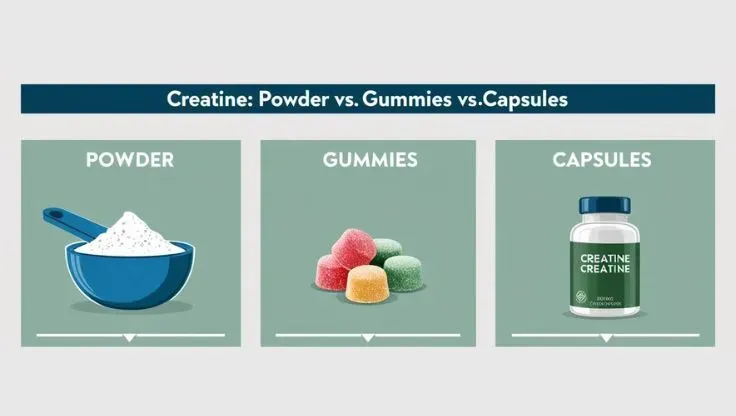Understanding the Different Forms of Creatine
1. Creatine Powder
Creatine powder is the most popular and versatile form. It's widely used because of its affordability, effectiveness, and flexibility in dosing.
Advantages:
- Versatility: Easily mixed with water, juice, or your favorite protein shake.
- Cost-Effective: Typically the most affordable option per serving.
- High Dosage Control: You can adjust the amount to meet your specific needs.
Considerations:
- Mixing Required: Requires preparation, which may not be ideal for on-the-go use.
- Taste and Texture: Despite its generally neutral taste, some people find the texture or aftertaste unappealing, though flavored options are available.
What to Look for in Creatine Powder:
- Type of Creatine: Stick with creatine monohydrate—it's the most researched and effective form. According to the National Institutes of Health (NIH), creatine monohydrate is generally safe and effective for most people.
- Micronization: Micronized creatine dissolves better, mixes easily, and may reduce stomach discomfort.
- Purity: Look for brands with third-party certifications like NSF Certified for Sport or Creapure®, a high-quality German-produced creatine.
- Flavor Options: If you dislike the taste of unflavored creatine, opt for a flavored version with minimal added sugars.
Ready to try creatine powder? Check out this highly-rated micronized creatine monohydrate on Amazon!
2. Creatine Gummies
Creatine gummies are a convenient and tasty alternative, especially for those who dislike powders or capsules.
Advantages:
- Convenience: No mixing or preparation required—just grab and go.
- Flavorful: Available in a variety of flavors, making them enjoyable to consume.
- Portability: Perfect for travel or gym bags.
Considerations:
- Cost: Gummies are often more expensive per serving than powder or capsules.
- Added Ingredients: May contain sugars, sweeteners, or other additives.
- Lower Dosage: You may need to take multiple gummies to reach the standard 3-5g dose.
What to Look for in Creatine Gummies:
- Creatine Content: Ensure each gummy provides a meaningful dose (e.g., 1-2g per gummy).
- Sugar Content: Opt for low-sugar or sugar-free options if you're watching your intake.
- Brand Reputation: Choose reputable brands with transparent labeling and third-party testing.
Looking for a tasty creatine option? Try these sugar-free creatine gummies on Amazon!
3. Creatine Capsules
Creatine capsules offer a no-fuss, portable option for those who prefer simplicity.
Advantages:
- Portability: Easy to carry and take on-the-go.
- No Taste or Texture Issues: Swallow them whole without worrying about mixing or flavor.
- Consistent Dosage: Each capsule provides a fixed amount, ensuring consistency.
Considerations:
- Cost: Capsules are typically more expensive than powder.
- Dosage Limitations: You may need to take multiple capsules to reach the recommended dose.
- Filler Ingredients: Some capsules contain unnecessary additives—check the label.
What to Look for in Creatine Capsules:
- Dosage per Capsule: Look for capsules with at least 500 mg of creatine monohydrate.
- Brand Reputation: Choose trusted brands with third-party testing for quality assurance.
- Convenience: If you dislike swallowing pills, capsules may not be the best option.
Prefer capsules? Check out this high-quality creatine monohydrate capsule option on Amazon!
Which Form of Creatine is Right for You?
The best form of creatine depends on your lifestyle, preferences, and budget:
- Powder: Ideal for those who want versatility, affordability, and precise dosing.
- Gummies: Great for convenience and taste, but watch out for added sugars.
- Capsules: Perfect for portability and simplicity, though they may cost more.
Complementary Products to Enhance Your Creatine Routine
To maximize your results, consider pairing creatine with these fitness essentials:
- Protein Powder: Supports muscle recovery and growth. Check out this top-rated whey protein on Amazon!
- Shaker Bottle: Makes mixing creatine powder a breeze. Grab this leak-proof shaker bottle on Amazon!
- Fitness Tracker: Monitor your progress and performance. Explore this popular fitness tracker on Amazon!
Final Thoughts
No matter which form of creatine you choose, it's a proven supplement for boosting strength, performance, and muscle growth. According to the Mayo Clinic, creatine is generally safe for most people when used as directed. By considering factors like type, purity, and convenience, you can find the perfect creatine product to support your fitness goals.
Ready to start your creatine journey? Browse the best creatine supplements on Amazon today! Check out this highly-rated creatine supplement on Amazon!
References
DISCLAIMER: At BodyMetrics.Pro, we believe that fitness, nutrition, and health-related topics must be approached with seriousness and responsibility. We carefully select our sources, prioritizing authoritative and reliable references to ensure that our readers receive the most credible information possible. However, no content on this website should ever be used as a substitute for direct medical advice from your doctor or other qualified clinician. Below, you will find the list of sources we have consulted for this post:
- NIH (National Institutes of Health)/MedlinePlus: Creatine - Backs up the effectiveness and safety of creatine monohydrate.
- Mayo Clinic: Creatine Overview - Provides a general overview of creatine's safety and benefits.
